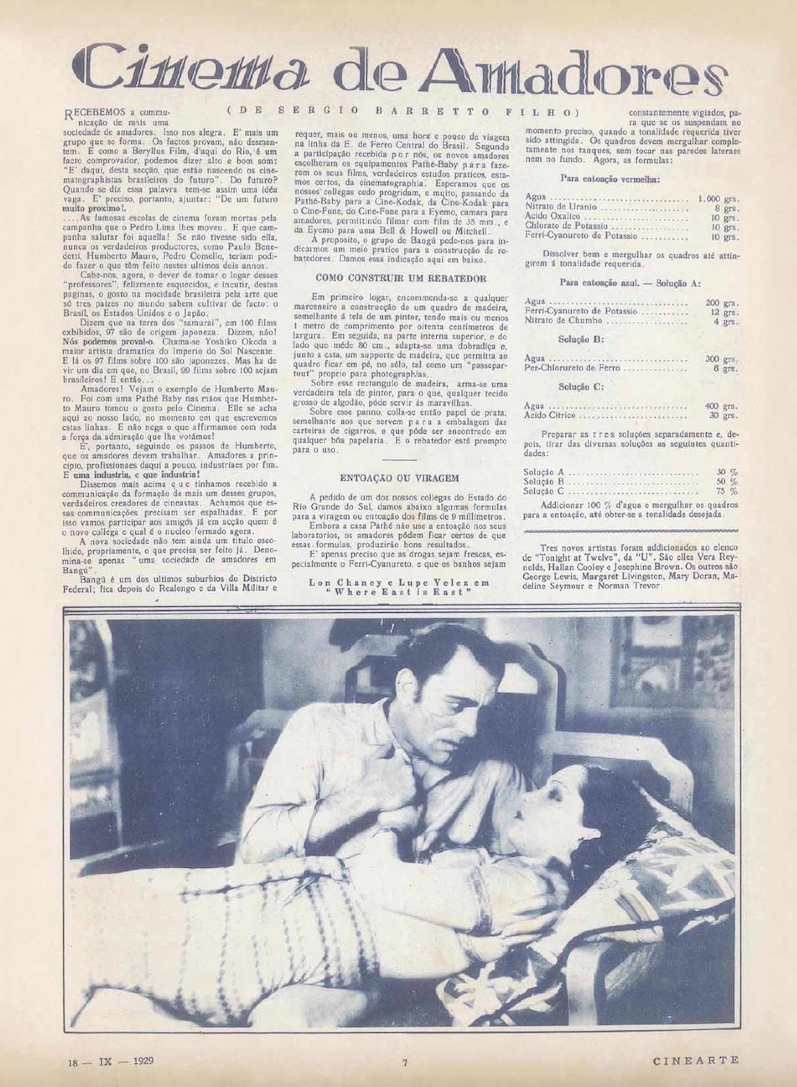Amateur Cinema
by Sérgio Barreto Filho (translated by Rielle Navitski)
Cinearte, September 18, 1929, 7.
We received a communiqué from yet another society of amateurs. This pleases us. Yet another group that is forming. Events prove it, they do not contradict it. And as Beryllus Film, here in Rio, is a corroborating fact, we can say loud and clear: “It is here, from this section, that the Brazilian filmmakers of the future are being born!” Of the future? The word gives only a vague idea. It is necessary to add, therefore, “The very near future!”
…The famous film schools were killed off by the campaign that Pedro Lima waged against them. And what a salutary campaign it was! Without it, the true producers, like Paulo Benedetti, Humberto Mauro, [and] Pedro Comello could never have done what they did in the last few years.
It falls to us, then, to take the place of these “professors,” thankfully forgotten, and inculcate, from these pages, Brazilian youth’s taste for the art that only three countries in the world have truly learned to cultivate: Brazil, Japan, and the United States.
They say that in the land of the “samurai,” out of 100 films exhibited, 97 are of Japanese origin. They say? No! We can prove it. Yoshiko Okoda is the greatest dramatic artist of the Land of the Rising Sun. And there 97 out of 100 films are Japanese. But a day will come when, in Brazil, 99 out of 100 films will be Brazilian! And then…
Amateurs! Look at the example of Humberto Mauro. It was with a Pathé Baby in his hands that Humberto Mauro developed a taste for Cinema. He is sitting here at our side as we write these lines. And he does not deny what we affirm with all the force of the admiration we have for him!
Thus, it is following in the footsteps of Humberto Mauro that amateurs must work. Amateurs in the beginning, before long professionals, industrials in the end. An industry, and what an industry!
We said above that we had received a communiqué about the formation of another of these groups, [which are] true creators of cinéastes. We believe this news must be spread. And this is why we want to share with our friends already in action who their new colleagues are and what is the nucleus being formed.
The new association has not yet chosen a real title, which should be done as soon as possible. It simply calls itself “a society of amateurs in Bangú.”
Bangú is one of the most distant suburbs of the Federal District [at that time, Rio de Janeiro]; it comes after Realengo and Villa Militar and requires a trip of a little over an hour on the Brazilian Central Railway Line [to reach it]. According to the message we received, the new amateurs chose Pathé-Baby equipment to make their films, true practical studies, we are sure, of cinematography. We hope our colleagues soon progress, greatly, passing from the Pathé-Baby to the Ciné-Kodak, from the Ciné-Kodak to the Cine-Fone, from the Cine-Fone to the Eyemo, a camera for amateurs that allows shooting with 35mm film, and from the Eyemo to a Bell & Howell or a Mitchell.
